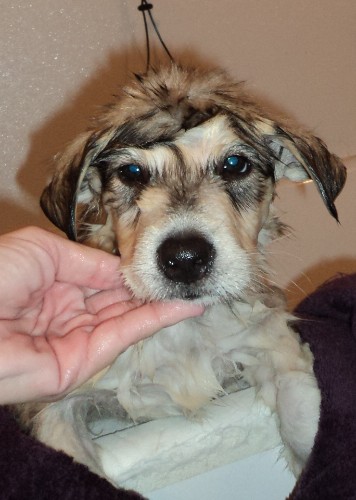
How to groom a dog applies to adult dogs primarily — it’s easier to bathe a puppy. Just climb in the tub, put the puppy between your legs, and go to it…. but this too shall change.
Not only do I groom sleddogs for the show ring, I have my own, plus rescues and boarders. Don’t do the math, its too depressing. We did 9 baths last Saturday — just like this… But no power blow outs.
This is NOT hard. It is labor intensive and you have to have a few tools.
Table with grooming arm — or a makeshift table pushed against a wall with a pair of screw-eyes inserted securely to hook the dog to. You need to be able to keep the dog at waist level without him leaving the area. I can’t emphasize enough how important it is that the dog is UP because your aching back will never let you do it a second time if you don’t put the dog UP. <s> I bathe and brush on the table. My dogs are NOT restrained, but they ARE on the table every week of their lives and the table is in a secure 10×10 kennel they know they have no chance of escaping.
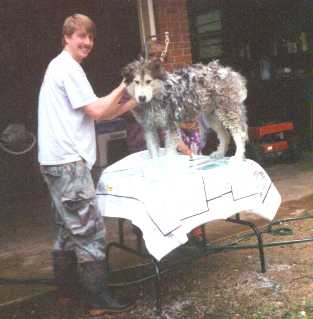
Hand tools. You’ll want a slicker, an undercoat rake, and a greyhound comb. ALL THREE. Plus toe nail trimmers. Either a Dremel grinder (which I prefer and most dogs do as well) or the guillotine-style hand clippers. And a power dryer if you have any sense whatsoever.
Shampoo and conditioner. Yes, in order to groom a dog, you start with a bath. I use the table and a garden hose this time of year. I prefer several shampoos:
- Chris Christensen’s White on White, Black on Black, Gold on Gold, After Bath, and Ice on Ice. No better products on the market than Chris’ — order online
- Lambert Kay’s Snowy Coat and Fresh N Clean — found at some petstores
- Petedge’s Citrilux shampoo
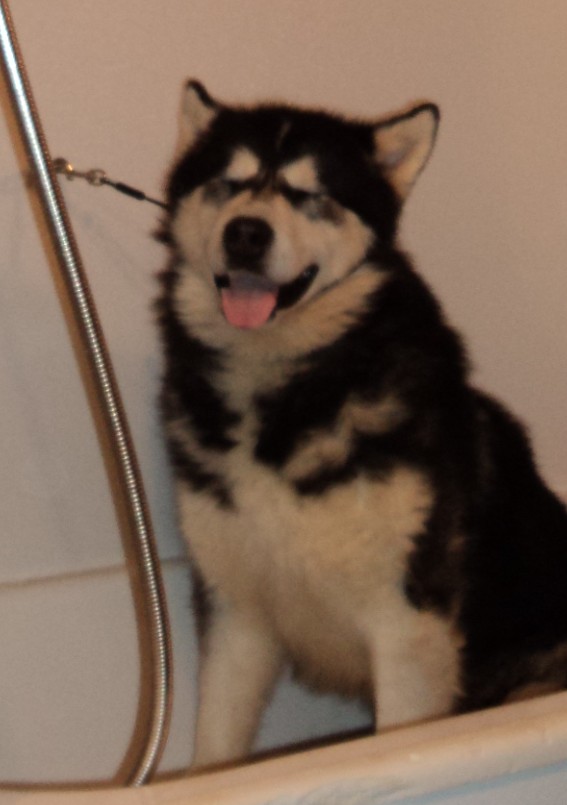
Except for Chris’ products, I don’t put any shampoo straight on a dog. Chris’ products are designed to, no other product is. So for everything but Chris’ products…. In an empty and clean milk gallon pour 1 quart of very warm water, and 1 cup of your shampoo. Put lid on and swirl/shake until mixed. This is a CONCENTRATED shampoo at this stage. When you use it you will dump 1/2 cup concentrated shampoo into 1 quart WARM water, swirl/shake, and apply directly to coat and lather. So it will be twice thinned down.
I can’t emphasize enough, never pour straight shampoo on a dog, or a human, no matter what brand. Pre-lathering and pre-diluting — ALL BRANDS — is crucial if you want the shampoo to work correctly. A lathered dog will get clean. A dog with slimy shampoo on him will never be clean no matter how much you lather afterwards but will have dandruff or worse as well thanks to the straight chemicals you put on his skin.
How to bathe a dog — Brush him first. Using the under coat rake, take out the big pieces and fluff pieces, pick them out or rake them out, but get them out. Check for mats. No reason to wash dead hair if you can help it. If you have a forced air power dryer, say a prayer to the inventor, and use this. I hardly ever use ONLY a hand-tool for pre-bathing, because my dogs are on the table so much with the dryer, that their coats are already separated and you’re just blowing the dirt and dust out. I power out my personal dogs every week. A dirty coat is a broken coat. A dirty coat means dirty skin. Dirty skin means skin problems. Including smell. Dead coat also smells, so brush weekly, with or without a forced-air dryer.

So if you only have hand-tools, use the undercoat rake. They make a lovely one with a double row of spinning teeth — works great for getting out dead hair. There is a tool I’m looking at called a FURminator, that is supposed to cut out the dead hair and not cut the guard coat, but you only use every 4-6 weeks and is supposedly stops dander and shedding, but the big dog one is $50 — which is why I don’t have one yet.
Take out all mats before you wet the dog. Water tightens mats. Try to groom them out, even if you hold the mat up with one hand, and pull the hairs loose from the bottom with the comb. If you have to use scissors, than put your finger on the other side of the mat, poke the scissors thru the mat against your finger — NOT THE DOG — and then cut out when you are sure that you are cutting hair and not dog. Everyone cuts dog if you do this long enough, but there is no need to if you are careful. Be sure and back-brush the belly, underarms, behind the ears, the throat, britches, and tail. Yes, the tail needs to be back-brushed. If your dog is fighting you — well, his head is controlled and you are on the non-teeth end, right? Some peanut butter in the roof of their mouth, or someone holding their head and scratching ears — while not getting bit — will help. BRUSH THE TAIL OUT before you start the bath. You can also brush out on the floor if they cooperate and your back cooperates.
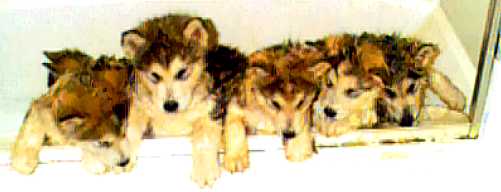
Put dog on table at waist height, secured to something so he can’t jump down. Wet the dog. This may take 10 minutes or more for a first wetting. A dog with a good coat will take longer. A dog with caked mud should have had the big pieces brushed out already but may need to be rinsed first before you can find the mats. Do what you can.
Once the dog is completely wet (he’s not, but you’ll think so), than you take your twice diluted warm water shampoo (in a SS dog food bowl works well) and pour over the back, then work palmfuls of soap into ALL parts of the dog. Start under one ear on the neck and work systematically all the way around the dog lathering so you don’t miss anything. LATHER CLEANS. Non-lathered areas are not going to be clean. Think of the suds in shampoo commercials. Suds clean. So you suds the entire dog, not forgetting between the front legs on the chest, between the rear legs below and behind — a dirty butt afterwards makes this whole process seem pointless. Work suds all the way thru the tail. You can dunk the tail and the feet in your sudsy shampoo in the SS dog bowl. Works great. SS bowls don’t shatter when they get kicked off the table either.
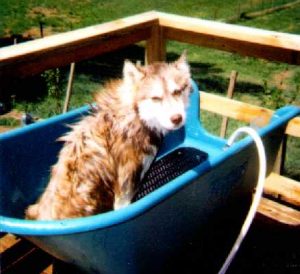
But what you are cleaning is SKIN. Don’t even think about cleaning hair, that’s a by-product of the process. You are cleaning the skin. So lather the skin. If the skin is lathered and massaged with soap than the hair will be as well.
Do the face, head, in front of the ears, and inside the ears last. Rinse those areas first. Soap in the eyes stings, we all know this in the shower and forget it when we’re cleaning someone besides us. You can use baby wipes in the ears, but I push the head down water or shampoo is BEHIND the ear and use my fingers to clean inside the ear. With the head pushed forward and down, is how I rinse as well.
When the whole dog is slimy — close your eyes and run your hands over every inch of the dog and slime the whole dog. Then rinse. Rinse. Lather again. The second lather should rinse out clean with no suds & no dirt. This rinse is very very important. You have to get all lather off the dog. The places that suds collect are generally between the front legs on the chest — feel with your eyes closed for suds, you’ll know, and in front of the ears because we are so careful and they hate their ears cleaned. And between the rear legs up in the groin area because we are all Puritans at heart and don’t want to be rude. Be rude. Pup doesn’t want a rash from shampoo left on.

And rinse.
And rinse.
And rinse. This rinse can take 20 minutes or more. If you don’t get all the chemicals out of the coat, you will regret ever starting. And so will your dog. Rinse until the coat feels clean and non-slimy under your hands. Check under the arms, in the groin, and in front of the ears.
When the dog shakes off, the hair will tend to stand up, almost separated — that’s the goal. The conditioner is what pulls the dead hair loose. Not always out, but definitely loose. I spend as much time on conditioning a dog as twice shampooing. I spend more time rinsing than either conditioning or shampooing.
Now is when you trim the toe nails. Dog has been wet for 30-45 minutes – or more. Toe nails are soft. If you quik the dog, you are in a position to see it because water makes everything RED and scary… Have on hand baking soda or Quik-stop. No big crisis. Things will be fine even if you do quik the dog. Shove the toe nail into the powder and it stops. But he will hate you… <s> And the table. Which is why I like the grinder at this point. Dogs don’t react as strongly to the grinder vibrating against their nail as the sudden jerk of the nail trimmers.

Towel dry the dog. Use 6 towels at least per dog. I’m not kidding here. You want the moisture OUT, GONE, AWAY. You shouldn’t brush a wet coat or a dry coat. Moist is the goal.
Let the dog run around and get the heebee-geebees because they are gonna anyway. They may even roll in the dirt if you let them near dirt. OK. Whatever, you’re not done yet. Towel the dog again. Get the moisture out.
Now, drape these wet towels over a wire crate except the front and the back. Put dog in the crate with more dry towels under him. Put a box fan against the back of the crate and point towards the front. Leave the dog in here for at least an hour — maybe 3.
Get your hand tools, and if you have one, your forced air dryer — NOT A HUMAN HAIR DRYER. The forced air dryer only ever gets warm and dries by forcing hair quickly over a dog and drying by evaporation, the human hair dryer dries with heat. Bad move using a human hair dryer on a dog. He will regret it.

Back on the table. Undercoat rake thru the whole dog — from back feet up the leg, to the back of the head. Always brush the hair backwards as it lifts the coat and lifted coat will mean air gets to the skin, a good thing. Start with the undercoat rake. When you think you are done, and have gotten out all the newly discovered mats you missed the first time, use the greyhound comb. When you think you are done with that, use the slicker.
This is where a house dog may benefit from coat dressing products like The Stuff, Crowne Royal Bodifyer, Biogrom mink oil spray, etc. This will increase the conditioning and separation of each hair — which is what keeps the skin clean and lets air down to the skin. But these products can collect dirt out in the yard, so consider how dry you’re going to be able to get the dog before he hits the dirt. I use the Stuff on my gray dogs, Mink Oil with sunscreen on my black or red or sable dogs, and the bodifyer when I’m out of either of the others. WONDERFUL detanglers all, and made for dogs.

With a dry dog that is clean and brushed you will be able to take the greyhound comb up the back leg, thru the britches, and up the whole spine to the back of the head — that’s what de-matting does. You will never get that way the first time, even tho you think you’re doing great. So start over with the greyhound comb and line comb.
Line combing, with or without a dryer, is taking your left hand (if you’re right handed) and pushing the hair UP on the back leg and with the comb in your right hand you will comb down, moving the comb only a quarter of an inch up the leg for each swipe. You are moving the comb in long strokes DOWN, but you are only moving UP the dog a quarter of an inch at a time.
With or without the forced air dryer, use all three tools. The forced air dryer means you can finish in 1 hour instead of 3.
By now the dog should be dry and brushed. You have haired-up every towel in the place. And you have got layers of dog hair on you, in your clothes, in your ears, and in your nose. Take a shower…

I wouldn’t groom someone’s dog for $40, which is the going rate locally. By the time this process is done, you’ll have bought a Power dryer $140-300, and a good rake $20 and a good greyhound $30, and your back will ache….What do you think this is worth? Learn to do it yourself and your dog will learn that attention on tables is a wonderful thing. My Singer falls asleep during the line combing flat on her side on the table, snoring away. Takes me 2 hours, start to finish, to do a show groom — if the dog is properly prepped and in good coat (no blowing or shedding or mats).